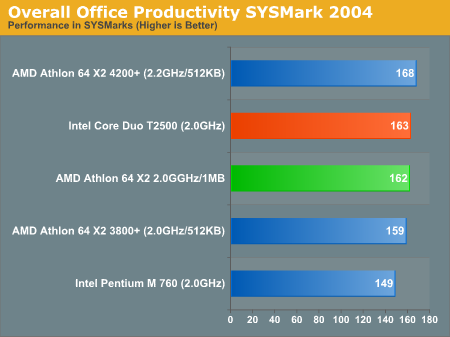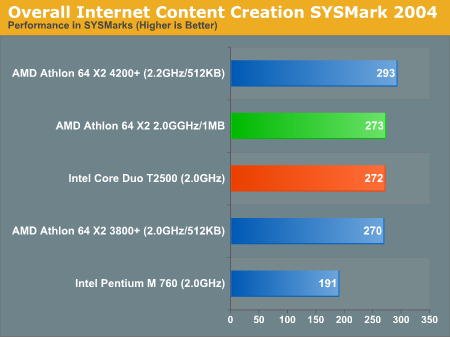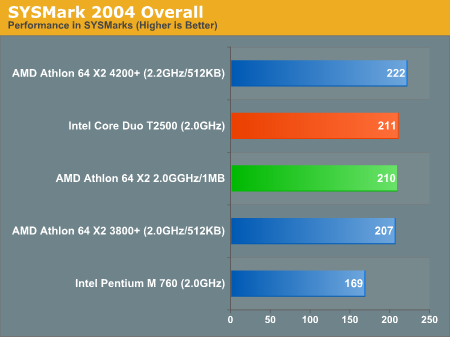Intel Core Duo (Yonah) Performance Preview - Part II
by Anand Lal Shimpi on December 19, 2005 12:55 PM EST- Posted in
- CPUs
Overall System Performance using SYSMark 2004
Office Productivity SYSMark 2004
SYSMark's Office Productivity suite consists of three tests, the first of which is the Communication test. The Communication test consists of the following:
Compared to the Athlon 64 X2, the Core Duo T2500 manages to slightly outperform the X2 3800+, but moving to a larger cache helps the X2 narrow that already small gap. Even though the Core Duo has a one-point lead, given the percentage, we'd call this one a tie.
The breakdown of the Office Productivity SYSMark 2004 score is listed below, higher numbers mean better performance:
ICC SYSMark 2004
The first category that we will deal with is 3D Content Creation. The tests that make up this benchmark are described below:
The breakdown of the ICC SYSMark 2004 score is listed below, higher numbers mean better performance:
Office Productivity SYSMark 2004
SYSMark's Office Productivity suite consists of three tests, the first of which is the Communication test. The Communication test consists of the following:
"The user receives an email in Outlook 2002 that contains a collection of documents in a zip file. The user reviews his email and updates his calendar while VirusScan 7.0 scans the system. The corporate web site is viewed in Internet Explorer 6.0. Finally, Internet Explorer is used to look at samples of the web pages and documents created during the scenario."The next test is Document Creation performance:
"The user edits the document using Word 2002. He transcribes an audio file into a document using Dragon NaturallySpeaking 6. Once the document has all the necessary pieces in place, the user changes it into a portable format for easy and secure distribution using Acrobat 5.0.5. The user creates a marketing presentation in PowerPoint 2002 and adds elements to a slide show template."The final test in our Office Productivity suite is Data Analysis, which BAPCo describes as:
"The user opens a database using Access 2002 and runs some queries. A collection of documents are archived using WinZip 8.1. The queries' results are imported into a spreadsheet using Excel 2002 and are used to generate graphical charts."

Compared to the Athlon 64 X2, the Core Duo T2500 manages to slightly outperform the X2 3800+, but moving to a larger cache helps the X2 narrow that already small gap. Even though the Core Duo has a one-point lead, given the percentage, we'd call this one a tie.
The breakdown of the Office Productivity SYSMark 2004 score is listed below, higher numbers mean better performance:
| OP SYSMark 2004 Score Breakdown | AMD Athlon 64 X2 4200+ | AMD Athlon 64 X2 3800+ | AMD Athlon 64 X2 2.0GHz/1MB | Intel Core Duo T2500 | Intel Pentium M 760 |
| Communication | 148 | 144 | 146 | 146 | 140 |
| Document Creation | 219 | 204 | 211 | 215 | 203 |
| Data Analysis | 145 | 136 | 138 | 138 | 117 |
ICC SYSMark 2004
The first category that we will deal with is 3D Content Creation. The tests that make up this benchmark are described below:
"The user renders a 3D model to a bitmap using 3ds max 5.1, while preparing web pages in Dreamweaver MX. Then the user renders a 3D animation in a vector graphics format."Next, we have 2D Content Creation performance:
"The user uses Premiere 6.5 to create a movie from several raw input movie cuts and sound cuts and starts exporting it. While waiting on this operation, the user imports the rendered image into Photoshop 7.01, modifies it and saves the results. Once the movie is assembled, the user edits it and creates special effects using After Effects 5.5."The Internet Content Creation suite is rounded up with a Web Publishing performance test:
"The user extracts content from an archive using WinZip 8.1. Meanwhile, he uses Flash MX to open the exported 3D vector graphics file. He modifies it by including other pictures and optimizes it for faster animation. The final movie with the special effects is then compressed using Windows Media Encoder 9 series in a format that can be broadcast over broadband Internet. The web site is given the final touches in Dreamweaver MX and the system is scanned by VirusScan 7.0."

The breakdown of the ICC SYSMark 2004 score is listed below, higher numbers mean better performance:
| ICC SYSMark 2004 Score Breakdown | AMD Athlon 64 X2 4200+ | AMD Athlon 64 X2 3800+ | AMD Athlon 64 X2 2.0GHz/1MB | Intel Core Duo T2500 | Intel Pentium M 760 |
| 3D Content Creation | 271 | 248 | 251 | 264 | 181 |
| 2D Content Creation | 340 | 312 | 314 | 323 | 238 |
| Web Publication | 274 | 254 | 257 | 236 | 162 |











103 Comments
View All Comments
Spoonbender - Monday, December 19, 2005 - link
Am I the only one recalling the old Athlon days?AMD smashes ahead with a great CPU, until around what, 2600+ or so, where they run out of steam, letting Intel overtake them.
Looks like the same might happen again...
Not sure if it's just AMD screwing up, or if it's really a question of resources.
For AMD, Athlon 64 was really a last-ditch gamble. They had to do something big, or they wouldn't exist 5 years from now.
Well, they did, and enjoyed a lot of success, but they might just not have the resources to follow up on it. Instead, their only option might be to milk the A64 for all it's worth, and then take a beating for a year or two, until they're ready with a next-gen architecture
LuxFestinus - Tuesday, December 20, 2005 - link
A question of availability needs to be raised. Are these new duo Intel processors available now? Can anyone say paper launch. How long has the dual Athlon64 been out? I thought so.Griswold - Monday, December 19, 2005 - link
I dont see where you're coming from. The A64 is a K7 on steroids. The P-M is a P3 on steroids and Conroe will also just be a P-M on steroids. Both companies didnt come up with flashy, brandnew architectures over the last few years, they only added flashy things to existing designs. Here and now, it's still Intel playing the catchup game until we see Conroe in stores. And then you always have to keep in mind that AMD is yet to move to 65nm. It will certainly give them some more clockspeed headroom.I agree with the conclusion of the article, we'll see a neck to neck race in a year from now where the better price will make the difference. AMD really doesnt have to flex its muscles now, they can milk the crowd with a superior product - and people will pay whatever to get it, or so it seems.
Calin - Tuesday, December 20, 2005 - link
Several of the flashy brand new architectures of the last few years had any kind of success. Itanium/EPIC, Transmeta, Netburst... As long as Transmeta was supported by a company with very little financial power (so their loss was somewhat expected), Itanium is crawling ahead on life support, and Netburst (while being king of the hill for a good time) will be discontinued.Griswold - Tuesday, December 20, 2005 - link
The point is: Netburst is certainly a design that could be considered newer or more radical compared to the P3->P-M->Yonah/Conroe/Merom route. In the end netburst was still a technical failure, but certainly not a financial mistake.Well and Epic, thats much older than you think. But yes, it never ended up where Intel wanted it to be: on the desktop.
allies - Monday, December 19, 2005 - link
It seems like with Intel's new chips, we're going to be back to a point where neither company has a true lead on the other. AMD is in great position at the moment, but they need to get their Turion X2 out to combat Intel's Centrino Duo. Otherwise, they'll find themselves losing laptop sales, an area which they've come a ways in.Right now, although clockspeed isn't increasing as fast as it once was, is a very exciting time for computer technologies. Parallelism, die shrinking, heat reduction, among other strides are paving the way to the future.
ncage - Monday, December 19, 2005 - link
Are you sure the improvements in games are due to the different Memory Controller technoliges? Are you sure its not the FPU?tfranzese - Monday, December 19, 2005 - link
I was thinking the same, considering his thoughts are pure speculation on his part. So, until Anand can provide data to back that up, he should stick to commending AMD's architecture rather than trying to credit all their success to the on-die memory controller (which surely helps, but it's only one part in the formula).I would doubt AMD is sitting idle though, and as they work on their next architecture will keep their lips sealed in order to maintain an element of surprise. Surprise like when they added SSE support to the Palomino and SSE3 support to Venice - both unexpected additions.
Furen - Monday, December 19, 2005 - link
The K8s execution core is pretty much the same as the K7s. If you compare performance (in games) between the two you'll notice that the K8 performs much better. This is due to the fact that it removes the FSB bottleneck (by integrating the memory controller), increases the width of the L2 cache (and the size) and dramatically drops the memory access latency. Sure there are other minor differences but they're mostly minor improvements, like better branch prediction, etc.tfranzese - Monday, December 19, 2005 - link
I don't see where the two of you are going with this and only serve my point that pinning the successes of the architecture on the memory controller is only speculation.